Indicator to YHWH’s Throne – Mount Meru
For the last six posts I have been writing all about the stars and really that was quite a bit for you to digest. You will be happy to find that this post is going in a slightly different direction and while it does allude to a star, we are now seeking a mountain.
In a previous post I discussed how the north star, Polaris, could be the indicator of the position of YHWH’s throne in heaven. Also, interestingly, the stars are seen to form a circle around Polaris when captured by the open lens of a camera AND the magnificent colours of the Aurora Borealis, found in the North, readily reflect the colours of the throne of YHWH. What I have been discovering more recently is that there might well be another indicator which points to YHWH’s heavenly residence. Let us begin.
We all know that compasses point to what is called the magnetic north and that wherever we are on the earth, the needle will faithfully point towards the north. What is interesting about this is that very old maps of the earth show a magnetic mountain in what we call the North Pole and this has been referred to as Mount Meru and Rupes Nigra by mapmaker Gerardus Mercator.
In the Book of Enoch Chapter 18 we read: “₅…I saw the paths of the angels. I saw at the end of the earth the firmament of the heaven above. And I proceeded and saw a place which burns day and night, where there are seven mountains of magnificent stones, three towards the east, and three towards the south. ₇ And as for those towards the east, one was of coloured stone, and one of pearl, and one of jacinth, and those towards the south of red stone. ₈ But the middle one reached to heaven like the throne of God, of alabaster, and the summit of the throne was of sapphire. ₉ And I saw a flaming fire. And beyond these mountains ₁₀ is a region the end of the great earth: there the heavens were completed. Then in Chapter25 v1 we read: “From thence I proceeded to the middle of the earth, and beheld a happy and fertile spot, which contained branches continually sprouting from the trees which were planted in it. There I saw a holy mountain, and underneath it water on the eastern side, which flowed towards the south. I saw also on the east another mountain as high as that; and between them there were deep, but not wide valleys.”
Mercator was fascinated by the science of magnetism and in 1541 had added a magnetic isle to his maps. At an earlier date Johannes Ruysch’s world map published in Rome in 1517 has four islands around the Pole and its legend mentions, among its sources, the book of the Inventio Fortunatae. These islands appeared again in Phrysius’ 1534 world map. The Marine map by Olaus Magnus (1539) presented both the four islands and the magnetic mountain.
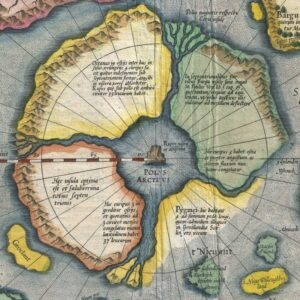
In 1577, Mercator wrote a letter to John Dee referring to an expedition going beyond Greenland in about 1360 which was made by “an Englishman from Oxford, probably from a monastic background.” He, the friar, “went to those islands; and leaving them, advanced still farther by magic arts (this refers to using a combination of Maths and Science) and mapped out all and measured them.” He described four canals which “flow with such current to the inner whirlpool, that if vessels once enter they cannot be driven back by wind.” (Mercator’s letter to John Dee can easily be found as a PDF).
The Friar specified that a chain of mountains formed a wall of northern islands, with the exception of some apertures into which 19 channels flowed. The largest one was 12 French miles, the narrowest ¾ mile, and here no ship could have passed due to the strong current. Besides the 19 channels, another five were joined together and flowed into the closed sea…In the middle there was the enclosed sea, 12 French miles wide. On the other side there
extended a splendid plain, among the most salubrious of the north. In the centre of the enclosed sea there was a vortex into which flowed the four internal seas of the Pole. The water moves, he writes, in a circle and goes down into the depths of the earth, as though it were being poured into a funnel, and the aperture is almost eight degrees. In the middle of the sea there is a mountain 33 Frenchmiles wide, completely made of magnet, “black”, “glistening” and as high as the clouds.
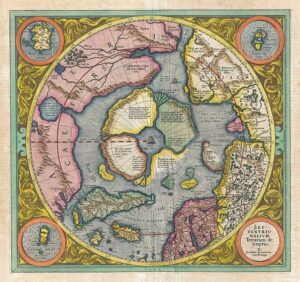
A recent assemblage of pieces of a map made in 1587 by Urbano Monte has been published by the David Rumsey Map Collection at Stanford University. The extraordinary 60 sheet manuscript world map is known as a Planisphere and is the largest known early map of the world. It was hand drawn by Monte in Milan, Italy, and only one other manuscript copy exists. The digitally joined 60 sheet map image below is the first time the map Monte made has been seen as one unified map – as Monte intended – in the 430 years since it was created. “The assembled map, just over 10 feet in diameter, is one of the largest—if not the largest—world maps made in the 16th century. The degree of detail and decoration is stunning and the entire production is surely unique in the history of cartographic representation.” (Information found on the David Rumsey website).
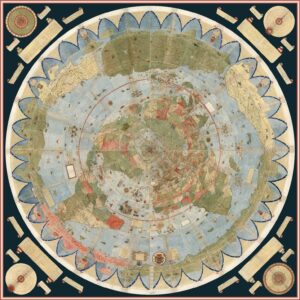
Once again, we see a mountain depicted at the centre of the map. Is this perhaps YHWH’s Holy Mountain spoken of in Psalm 48? (I realise that it says Mount Zion, but I also understand from research that some places we now think we know of their location are, in fact, not necessarily their location…oh dear, I feel we are tumbling down another rabbit-hole, so bear with me on this).
Great is the Lord, and greatly to be praised
In the city of our God,
In His holy mountain.
2 Beautiful in elevation,
The joy of the whole earth,
Is Mount Zion on the sides of the north,
The city of the great King.
From His lofty heights in the Heaven above the firmament, YHWH looks down at every stage of His Creation over the six days that it takes place. He sees every detail and He sees that which is good; He sees everything that humans do as He sits in pole position – perhaps indicated by the magnetic north pole where Mount Meru is said to stand, also by the circle of colour emitted by the Aurora Borealis and not least by Polaris, the North Star around which all other stars appear to circle through the night.
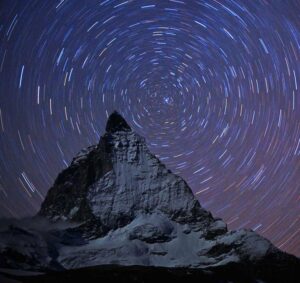
We read in Genesis 11 v 4 that men strove to construct a tower with its top in the heavens with the idea that they might somehow break into the Heavenly Realm which is YHWH’s abode. What sheer folly! Of course YHWH would not allow such a thing, if it were at all possible.
In Isaiah 14:13 we read: For you have said in your heart, I will ascend into heaven, I will exalt my throne above the stars of God: I will sit also on the mount of the congregation, in the sides of the north. The Chaldæan king of Babylon wanted to be like a God and so what was it he wished to climb to achieve this feat? Barnes’ Notes on the Bible explores this:
I will sit also upon the mount of the congregation – The word rendered ‘congregation’ מועד mô‛êd from יעד yâ‛ad “to fix, appoint” properly means a fixed or definite time; then an “appointed” place of meeting; then a meeting itself; an assembly, a congregation. What is referred to here it is difficult to determine. The Septuagint renders it, ‘On a high mountain, on the lofty regions which lie to the north.’ The Chaldee, ‘I will sit in the mount of covenant, in the regions of the north.’ Grotius supposes that when the king of Babylon said he would ascend into heaven, he meant the land of Judea, which was called heaven because it was dedicated to God; that when he said he would ascend above the stars, he meant to denote those ‘who were learned in the law;’ that by the ‘mount of the congregation,’ he meant mount Moriah where was the temple; and that by the ‘side of the north,’ he meant mount Zion, which, he says, was on the north of Jerusalem. It is remarkable that the usually accurate Grotius should have fallen into this error, as mount Zion was not on the north of Jerusalem, but was south of mount Moriah…
(1) The terms here employed ‘the mount of the congregation,’ ‘the sides of the north,’ are not elsewhere applied to mount Zion, and to mount Moriah. (2) It does not correspond with the evident design of the king of Babylon. His object was not to make himself master of Zion and Moriah, but it was to exalt himself above the stars; to be elevated above all inferior beings; and to be above the gods. (3) It is a most forced and unnatural interpretation to call the land of Judea ‘heaven,’ to speak of it as being ‘above the stars of God,’ or as ‘above the heights of the clouds;’ and it is clear that the king of Babylon had a much higher ambition, and much more arrogant pretensions, than the conquest of what to him would be the comparatively limited province of Judea.
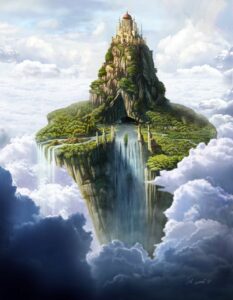
It is evident, therefore, I think, that the king of Babylon did not refer here to Judea, or to Zion. The leading idea of his heart, which ought to guide our interpretation, was that he designed “to ascend in authority over all inferior beings, and to be like the Most High.” We are to remember that Babylon was a city of idolatry; and it is most probable that by ‘the mount of the congregation, in the sides of the north,’ there is reference to a belief prevalent in Babylon that the gods had their residence on some mountain of the north. This was a common opinion among the ancients. The Hindus call that mountain “Meru;” the Persians, who are followers of Zoroaster, “Al Bordsch;” the Arabs, “Kafe;” and the Greeks, “Olympus.” The common opinion was that this mountain was in the centre of the world… Such a mountain would “appear” to be under the north-pole, and the constellations would seem to revolve around it. It is not improbable that the Aurora Borealis, playing often as it does in the north with special magnificence, might have contributed to the belief that this was the special abode of the gods… The north is often mentioned as the seat of the whirlwind, the storm, and especially as the residence of the cherubim. Thus in Ezekiel’s vision of the cherubim, the whole magnificent scene is represented as coming from the north – as if the appropriate abode of the cherubim: ‘I looked, and lo! a whirlwind from the north…Came sweeping onward, a vast cloud that rolled.’
Other verses which indicate where YHWH’s throne might be positioned are mentioned in the image below.
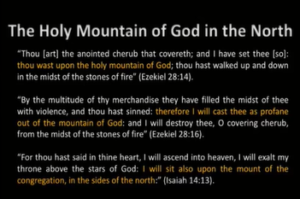
Let us look a bit further into this mount beneath the throne as I have often wondered if when Satan tempted Yeshua, did this take place on the highest mountain of the earth which could be Mount Meru? We read in Matthew 4: 8-10:
8 Again, the devil taketh him up into an exceeding high mountain, and sheweth him all the kingdoms of the world, and the glory of them; 9 And saith unto him, All these things will I give thee, if thou wilt fall down and worship me.10 Then saith Jesus unto him, Get thee hence, Satan: for it is written, Thou shalt worship the Lord thy God, and him only shalt thou serve. (KJV)
Note that when Satan took Yeshua to “an exceedingly high mountain” he showed Him “all the kingdoms of the world.” Many commentaries surmise where this mountain could be, but no scholar can really know its position, it would appear. This mountain was of such a height and had such a view that Yeshua was able to see ALL the kingdoms of the world at that time; “not only the Roman empire—though that was, to be sure, the greatest in the world at that time; but all the kingdoms in the whole world, which subsisted in any form, whether within, or independent of the Roman empire; or whether greater or lesser: and by “the glory of them”, is meant, the riches, pomp, power, and grandeur of them.” [paraphrase: Biblehub.com]
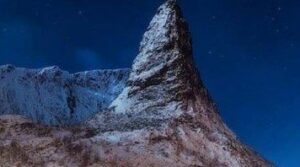
If Mount Meru at the North Pole is an indicator of where YHWH’s throne sits above the firmament, then two questions must arise in the reader’s mind. Firstly, how could Yeshua actually see the whole world and secondly if Mount Meru is an indicator of YHWH’s throne, and Satan knew this, then did he have to wait for a particular time of day to make sure that YHWH’s throne was directly above the indicator? In other words, if the earth spins and is a ball, then both these biblical events, recorded in YHWH’s Holy Book, cannot be read as facts but as some fantastical story or allegory. However, if I believe that the Bible is a book of truths, then I cannot pick and choose which passages to believe are actual facts and which are not; this is a very slippery path which could end up with my not believing that Yeshua is the real Messiah! (I do, however, realise that some things written in the Bible are visions – but the Holy Word always makes this clear, so that I am not fooled!). What I am trying to say here, dear reader, is that the Bible says that the earth is not a ball but a plane.
With this stunning (for some) revelation about the world we live on in mind, I turn to the help of a fellow blogger and author here at Unexpected Cosmology, Noel Hadley, who has done sterling research on what we can now call the Plane and in his book Avoid Science Falsely So-Called: Flat Earth, the Reformation, and the Science Delusion makes a list of some of the verses in the Bible which speak of YHWH’s creation and the Earth’s appearance and position:
“The man who has repented of his glaring error holds up the pages of Holy Writ for all to see. He runs his finger across any number of scripture passages, there are over a hundred of them, which give in great length the nature of the Lord’s created cosmology. He shows them the firmament (Genesis 1:6, Psalm 19:1), how it is spread out as molten glass (Job 37:18), the Earth being created before the sun and the stars (Genesis 1:1), the waters above the firmament which once drowned the world in the Great Deluge and, according to the Psalmist, still resides there (Genesis 7:11, Psalm 148:4), God’s throne built upon the firmament (Ezekiel 1:26), the sun and the moon under the firmament (Genesis 1: 14-18), the pillars of the Earth (Proverbs 8:29), the waters below the Earth, fountains of the deep (Proverbs 8:28), the sun moving in our stead, and with a circuit to run (Psalm 19:4-6), the stars shall fall to Earth (Matthew 24:29, Revelation 9:13), and last but certainly not least, the Earth is fixed forever in place, immovable (Psalm 93:1, 96:10).”
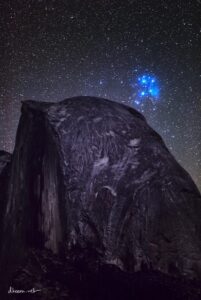
To conclude, it does not matter whether or not we can pinpoint the throne of YHWH, what we need to remember is that YHWH is all-seeing and all-knowing: For He looked down from His holy height; From heaven the LORD gazed upon the earth.(Psalm 102:19) But most of all we need to grasp onto the fact that YHWH in His compassion allowed us a way to reach Him in His Heavenly Realm through His Son Yeshua: “For God so loved the world, that he gave his only Son, that whoever believes in him should not perish but have eternal life.” (John 3:16). We do not need a mountain to climb up to Him!
And finally, let us remember how great is our Lord; Creator of all things:
Job 26
6 Sheol is naked before Him,
And Destruction has no covering.
7 He stretches out the north over empty space;
He hangs the earth on nothing.
8 He binds up the water in His thick clouds,
Yet the clouds are not broken under it.
9 He covers the face of His throne,
And spreads His cloud over it.
10 He drew a circular horizon on the face of the waters,
At the boundary of light and darkness.
11 The pillars of heaven tremble,
And are astonished at His rebuke.
